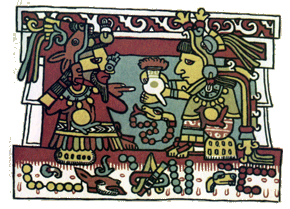The Mixtec
The Mixtecs were one of the most influential ethnic groups to emerge in Mesoamerica during the Post-Classic. Never a united nation, the Mixtecs waged war and forged alliances among themselves as well as with other peoples in their vicinity. They also produced beautiful manuscripts and great metal work, and influenced the international artistic style used from Central Mexico to Yucatan.
During the Classic period, the Mixtecs lived in hilltop settlements of northwestern Oaxaca, a fact which is reflected in their name in their own language, Ñuudzahui, meaning "People of the Rain." Later, during the Post-Classic, the Mixtecs slowly moved into adjacent valleys and then into the great Valley of Oaxaca. This time of expansion is no doubt recorded in a large number of deerskin manuscripts, called codices, only eight of which have survived. Nevertheless, these manuscripts allow us to trace Mixtec history from 1550 CE back to 940 CE, deeper in time than any other Mesoamerican culture except the Maya.
Mixtec Codices
Mixtec Codex Zouche-Nuttall
Mixtec codices were made of deerskin and folded like an accordion.
Mixtec codices represent a type of writing that's classified as logographic, meaning the characters and pictures used represent complete words and ideas instead of syllables or sounds. In Mixtec, the relationships among pictorial elements denote the meaning of the text, whereas in other Mesoamerican writing the pictorial representations are not incorporated into the text. Common topics found in the codices are biographies of rulers and other influential figures, records of elite family trees, mythologies, and accounts of ceremonies.
A Warrior Scene from the Codex Zouche-Nuttall
The above detail from the Codex Zouche-Nuttall depicts a group of warriors conquering a town (an event noted by the warriors' drawn weapons and the arrow piercing the hill). Above each participant's head is a glyph, or pictograph, with a dot. The glyphs below the warriors are calendrical day signs. They are also, however, the names of Mixtec nobles; among Mixtec nobles, a person's name is often his or her birthday.
Pre-Columbian Mixtec are mainly concerned with histories. They record historical events such as royal births, wars and battles, royal marriages, forging of alliances, pilgrimages, and death of rulers. In addition to the calendrical signs used for dating events and naming individuals, the Mixtecs used a combination of conventionalized pictures as well as glyphs to illustrate the type and nature of the event. One example is the wedding scene, usually shown as two individuals of opposite sex facing each other and sitting on jaguar-pelt chairs, as illustrated by a scene from the Codex Zouche-Nuttall which records the marriage of the legendary Mixtec King 8 Deer "Tiger Claw" of Tilantongo to Lady 12 Snake in 1051 CE.

A Marriage Scene from the Codex Zouche-Nuttall
This arrangement of the bride and groom is a purely pictorial convention, with no connection to the language. This means that no idiom or phrase in the Mixtec language describing two people sitting facing each other is a metaphor for marriage. However, the cup of chocolate held by Lady 12 Snake may represent the expression ynodzehua, which means "dowry" in Mixtec, where the root dzehua means "chocolate." Chocolate or cacao was one of the most expensive and luxurious products in Mesoamerica, and cacao beans were used as currency. It is no surprise the word for dowry would be based on chocolate.